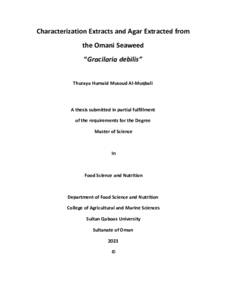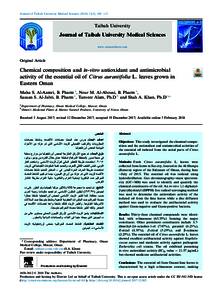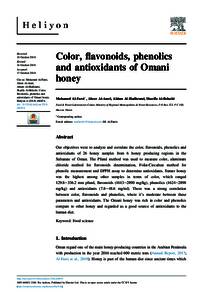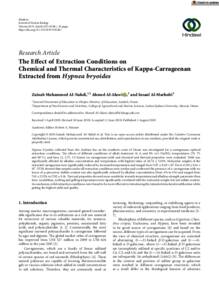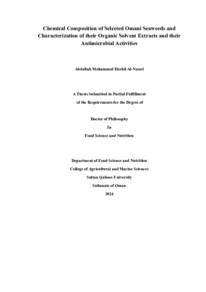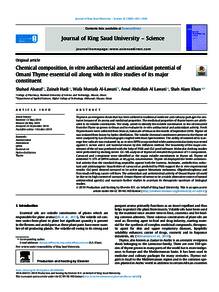Document
Characterization extracts and agar extracted from the Omani seaweed "Gracilaria debilis".
Publisher
Sultan Qaboos University.
Gregorian
2023
Language
English
English abstract
The Sultanate of Oman's coastline is abundant in many natural raw materials, such as seaweed
plants. Red seaweeds are rich in a variety of nutrients, including lipids, minerals, vitamins,
polyphenols, and carbs. These substances have a variety of uses in the food industry as well as in
pharmaceutical, nutraceutical, and cosmetic products. A significant amount of agar was discovered
to be present in Gracilaria debilis species that belong to the Rhodophyta group (Red seaweed).
This study aimed to determine the proximate composition of the species Gracilaria debilis, extract
its organic solvent-soluble compounds as well as investigate its polyphenols contents (TPC, TFC,
and TTC), and extract agar and study its functional, biological and chemical properties. The non water-soluble molecules were extracted using three different organic solvents sequentially (ethyl
acetate, acetone and methanol). The agar was extracted by hot water (90oC for 2h). High Performance Liquid Chromatography (HPLC) was performed to study the monosaccharide
composition of agar and profiling. The structural characteristics of the organic solvent extracts and
agar were analyzed by Fourier Transform Infrared (FTIR-ATR) technique. The finding of this
study showed that the ash (69.78 ± 1.98%) were the most abundant components in G. debilis,
followed by carbohydrates (20.63 ± 2.00 %) and protein (8.09 ± 0.03%), and the lipid content was
found the lowest (1.45 ± 0.03%). The main essential minerals found in the sample were Na, K, Ca,
P, Fe, where the k was detected with the highest concentration (48.72 ± 0.67 mg/g). The methanolic
extract exhibited the highest polyphenols contents (154.2 ± 4.58, 30.14 ± 0.20, and 409.35 ± 2.91
mg/g of TPC, TFC and TTC, respectively) among the three fractions. Methanol extracts (38 ± 0.40
U/ml) showed higher value of antioxidant capacity with hydrogen peroxide than ethyl acetate (33.6
± 0.69 U/ml) and acetone (30.66 ± 1.61 U/ml) extraction. The total yield of agar was 21.4 ±
0.812%. The agar showed a high antioxidant capacity at 0.9 % of extracted agar and gel strength
(120.1±5.3 g/cm2
) at 2.0% of KCl concentration. Polysaccharides in agar from G. debilis mainly
consist of Galactose (65.75 ± 1.61%), glucose (18.80 ± 2.49 %), with small amounts of mannose,
glucuronic acid, glucuronic acid, galacturonic acid, xylose fucose, and arabinose. In addition, the
structural characteristics demonstrated presence of ester sulfate (1380 -1355 cm-1), Galactose 4-
sulfate (850-845 cm-1) and Galactose 6-sulfate (820 cm-1) structures in the agar extract where, the
sulfate content was found (12.13 ± 0.73%). In conclusion, significant amounts of polyphenols were
discovered in the organic solvent extracts from G. debilis, Furthermore, the agar composition
displayed excellent functional, biological, and chemical characteristics. Where it can be utilized in
food industry as thickening, gelling, stabilizing, and antioxidant agents. Future research could also
concentrate more on protein extraction from G. debilis and investigate its biological, chemical,
and functional characteristics.
Member of
Resource URL
Category
Theses and Dissertations

